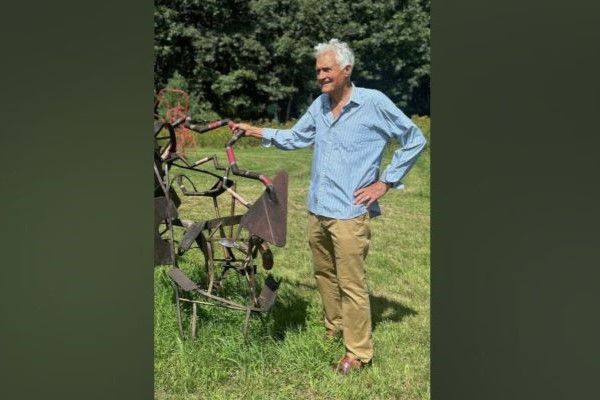Local Spotlight: Patrik Pierce
 |
Visiting the property that’s the palette for Patrik Pierce’s art brings to mind the pages of a Dr. Seuss book come alive: tall metal sculptures in all shapes, heights and forms rise from the field of grass, while some are half-hidden in the bordering woods. A barn adjacent to the old farmhouse is like a funhouse – full of surprises.
It’s like immersing oneself in an alternative universe on the outskirts of Saco.
“It feels like home here,” Pierce said. He characterized the 1834 home he shares with his wife, Kathleen Pierce, who works in hospitality, “hidden in plain sight.”
The artist, poet and writer grew up in Beaverton, Ore., which, he said, is very much like his adopted city. He moved to what is now named Two Diamond Art Farm in Saco a little more than 10 years ago.
Pierce said the rural location has evolved with his work, with his provocative pieces standing like benevolent sentinels around the 4-acre spread.
How do your surroundings inform your art?
I live and work here. All 4 acres are my studio. Blasts of big nature opened me to the majesty and power and sustainability of nature. It’s who I am … I’m in a dialogue with this microecology.
What was the first piece of art you created?
In my 20s I carved a little piece of wood into a standing sculpture of birds. It’s like a mini totem. Carved wood is kind of where I began.
Much of your work comprises metal, wood, and other 3-D materials fashioned from found materials. What was your coolest find ever?
When I lived in Lowell (Mass.) there were many former factories left to molder and rot. There were great pickings. One pipe was like a big sumi brush stroke balanced in the moonlight. I went back and got it. It’s called ‘Trillium’.
What’s your educational background and how did it influence you?
I was an English major, which gave me the breadth and mind to embrace life.
Tell us about the process.
I rarely work with unaltered pieces; I cut them up (to create a) new context. I was working with big pipes and laughing most of the time I put it together. It was almost comical. I laugh a lot when I work.
What’s your favorite and least favorite medium?
I do a lot of work with metal; it’s fluid. The elements of metal are like words in a poem I can compose. It’s a metaphor for life becoming whole, being here, really.
My least favorite is fiberglass because of the chemicals and I don’t like the process. I work primitively.
Who influenced you as an artist?
The painter Eugene Gregan from New York; Max Ernst, a German Dadaist; and Jean Arp, who worked in bronze and marble.
You also work as a poet and writer. Tell us about that.
I was a poet first, but I don’t answer to poet/artist because the label “artist” comes with a lot of baggage; it’s irrelevant to the art.
In a previously published article you said of your artwork, “The birds love it. They are my favorite critics.” In what way?
They shit on them. They perch on all of them.
What’s next?
A group show is just closing at Turtle Gallery in Deer Isle, where I first showed my work in Maine. I’m not planning anything right now; I’m not much of a planner.
Ann Fisher is a freelance journalist based in Saco. She can be reached at 432-7483.

